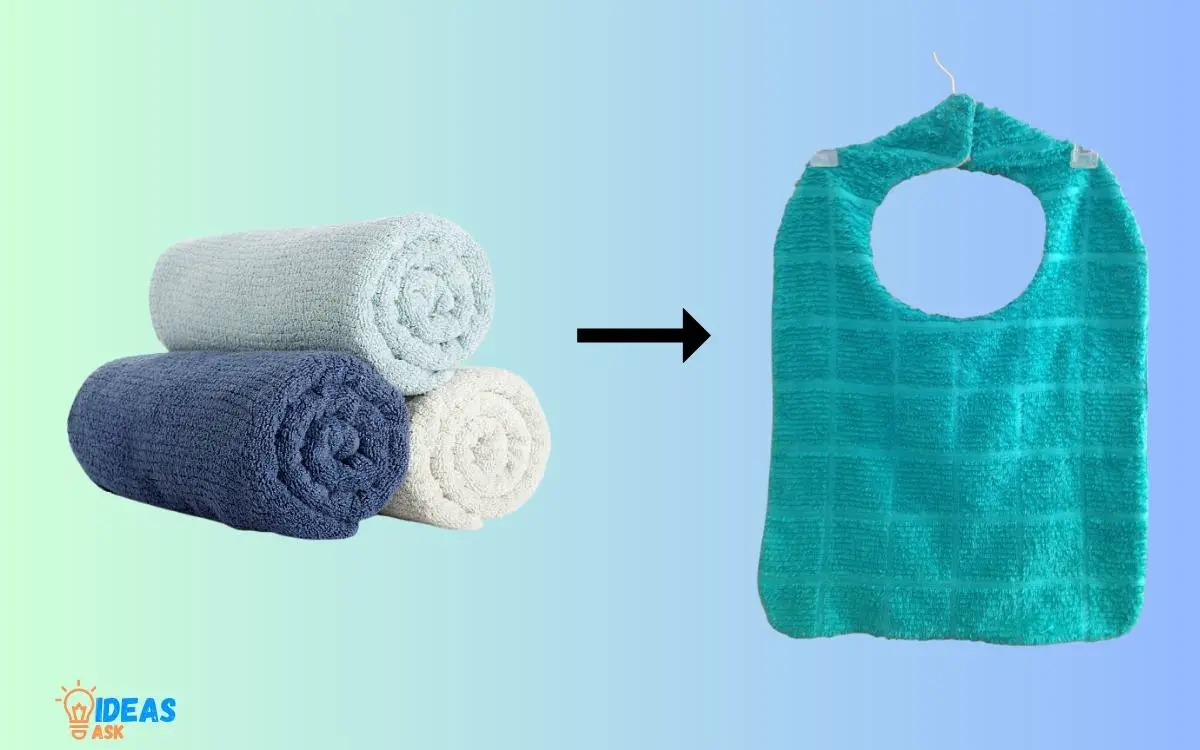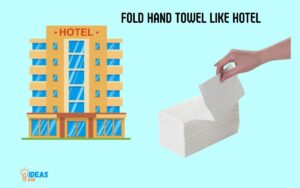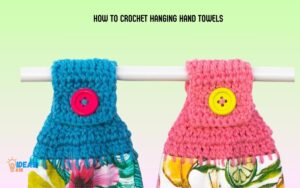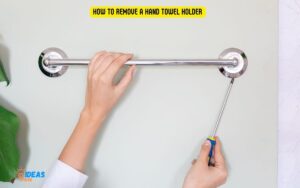How to Make a Bib from a Hand Towel? Step-By-Step Guide!
Making a bib from a hand towel is a simple DIY task that requires minimal equipment: a hand towel, scissors, a string, and a sewing machine.
To make a bib from a hand towel, you begin by folding the towel in half and cutting a semi-circle on the folded edge for the neck hole.
Once this is done, you then sew a string or ribbon on both ends of the neck hole to serve as ties. This can be done either by hand or with a sewing machine.
Creating a bib from a hand towel is a practical and cost-effective way to provide coverage during meal times, especially for infants and toddlers.
This not only allows you to repurpose old hand towels but also gives you the opportunity to create personalized bibs that are both functional and stylish.

Key Takeaway
Materials And Tools Required
Creating a bib from a hand towel is a simple DIY project that requires minimal materials and tools. With just a hand towel, scissors, and a sewing machine, you can easily transform the towel into a functional and stylish bib for your little one.
Hand Towel:
- A hand towel is the main material you’ll need to make a bib. It should be made of absorbent fabric like terry cloth, as it will help with spills and drools.
- Choose a hand towel that is large enough to cover your baby’s chest and lap comfortably, usually around 18 x 24 inches in size.
- You can opt for a hand towel with a fun pattern or color to make the bib more visually appealing.
Scissors:
- Scissors are essential for cutting the hand towel to the desired bib shape and size.
- Ensure you have a sharp pair of scissors to make precise cuts without fraying the fabric.
Velcro Or Snaps:
- Velcro or snaps are used to fasten the bib around your baby’s neck, providing an adjustable closure.
- Velcro is a convenient option as it is easy to use and secure. Make sure to choose a velcro strip suitable for fabrics.
- Snaps are another alternative that offers a more secure closure but may require access to a sewing machine or professional assistance to attach.
Sewing Machine Or Needle And Thread:
- A sewing machine or needle and thread are required to secure the edges of the bib and attach any closures like velcro or snaps.
- If you have basic sewing skills or access to a sewing machine, it will expedite the process. However, bibs can be hand-stitched with a needle and thread as well.
Step-By-Step Guide To Making A Hand Towel Bib
Learn how to make a practical bib from a hand towel with our step-by-step guide. This easy DIY project is perfect for parents and caregivers looking for a budget-friendly and customizable option to protect their little ones during mealtime.
Making a bib from a hand towel is a practical and convenient way to protect your clothes during mealtime or crafting activities. With just a few simple steps, you can transform a regular hand towel into a functional and stylish bib.
Follow this step-by-step guide to create your very own hand towel bib.
Measuring And Marking The Hand Towel:
- Lay the hand towel flat on a clean, spacious surface.
- Measure and mark the desired dimensions for your bib using a fabric marker or chalk. The typical size is around 16 inches wide and 18 inches long, but you can adjust the measurements based on your preference and needs.
Cutting And Shaping The Hand Towel:
- Use fabric scissors to carefully cut along the marked lines to create the shape of your bib. Remember to leave extra fabric for the neck opening, which should be about 3-4 inches wide.
- If you’d like a rounded shape for the bottom of the bib, use a rounded object like a plate or bowl as a guide and trace along the edge before cutting.
Adding Velcro Or Snaps For Closure:
- Decide on the type of closure you prefer for your bib. Velcro or snaps are practical options that allow for easy and adjustable fastening.
- Attach the Velcro or snaps to the ends of the neck opening, ensuring they align for seamless closure. Sew them securely in place.
Sewing Or Hand-Stitching The Edges:
- Fold the edges of the bib approximately 1/2 inch towards the backside and pin them in place.
- Use a sewing machine or hand-stitching with a needle and thread to secure the folded edges. Make sure to stitch around the entire bib to prevent fraying.
Finishing Touches And Optional Embellishments:
- Remove any remaining pins and give the bib a final inspection to ensure all edges are neatly stitched.
- To add a touch of creativity, consider embellishing your bib with appliques, embroidery, or fabric trim. This is an optional step but can make your bib unique and personalized.
Now that you have mastered the art of making a hand towel bib, you can create one for yourself or as a thoughtful gift for someone else. The simplicity of this DIY project allows for customization and practicality, making mealtimes or messy activities a breeze.
Enjoy the process of transforming a humble hand towel into a functional and stylish bib that is sure to be appreciated.
Tips For Customizing And Upgrading Your Hand Towel Bib
Upgrade your hand towel bib with these helpful tips and customization ideas. Learn how to turn a hand towel into a functional and stylish bib in just a few simple steps.
Looking to add a personal touch to your hand towel bib? Here are some tips and ideas for customizing and upgrading your bib to make it one-of-a-kind:
Appliques And Embroidery
- Attach colorful and fun appliques to the front of the bib. Choose from a variety of shapes, such as animals, flowers, or letters, and sew them securely onto the towel fabric. This adds a playful and whimsical element to your bib.
- Get creative with embroidery! Use colorful threads to stitch patterns or designs onto the towel fabric. You can embroider your child’s name or initials, or create cute patterns like hearts or stars. Embroidery adds a personalized and decorative touch to your bib.
Pockets And Pouches For Storage
- Add a pocket to your bib for convenient storage. Sew a small fabric pocket onto the front of the bib where you can tuck in a spoon, a small snack, or a napkin. This allows for easy access to essential items during meals.
- Create a pouch on the bib by folding and sewing a larger fabric section on one side. This pouch can hold a small food container or keep messy utensils contained. It’s a practical addition for on-the-go feeding.
Waterproof Lining For Messy Eaters
- To make your bib more practical and effective at protecting your child’s clothing, consider adding a waterproof lining. Sew a layer of waterproof fabric, like PUL (polyurethane laminate), between the towel layers. This will prevent liquids from seeping through and staining clothes, making cleanup a breeze.
Personalization With Fabric Paint Or Markers
- Get artistic with fabric paint or markers to personalize your hand towel bib. Write your child’s name, draw cute designs, or even let your little one unleash their creativity by allowing them to decorate their own bib. This adds a personal touch and makes mealtime more fun.
Remember, when customizing your hand towel bib, always ensure that any additions or modifications are securely and safely attached.
Use child-friendly materials and avoid any small parts that could pose a choking hazard. With these tips, you can transform a simple hand towel into a unique and functional bib that your child will love!
Caring For And Maintaining Your Hand Towel Bib
Learn how to create a practical bib using a hand towel and ensure its longevity by following these simple care tips. Keep your bib in great condition with easy maintenance techniques.
Hand towel bibs are a simple and versatile solution for messy mealtimes or craft sessions. To ensure that your hand towel bibs stay in top shape and provide lasting functionality, it’s essential to practice appropriate caring and maintenance techniques.
Here are some washing instructions, fabric care tips, stain removal techniques, and tips for preventing shrinkage and color fading. Additionally, we’ll also explore how to store and organize your bib collection effectively.
Washing Instructions And Fabric Care Tips:
- Machine wash the hand towel bibs in cold water with a gentle cycle.
- Use a mild detergent that is suitable for both colors and whites.
- Avoid using bleach or harsh chemicals, as they can damage the fabric and the colors.
- Consider washing the bibs separately or with similar fabrics to prevent any bleeding or color transfer.
- To remove any food stains, pre-treat them with a stain remover before washing.
- Hang or lay flat to air-dry the bibs to maintain their shape and prevent shrinkage.
- Avoid using a dryer, as the high heat can cause the fabric to shrink and colors to fade.
Stain Removal Techniques:
- For food stains, gently scrape off any excess residue before treating the stained area.
- Apply a small amount of stain remover directly to the stain and let it sit for a few minutes.
- Gently rub the stained area with a soft brush or cloth to lift the stain.
- Rinse the bib thoroughly to remove the stain remover before washing.
Preventing Shrinkage And Color Fading:
- Follow the washing instructions mentioned above to avoid shrinkage.
- When it comes to color fading prevention, avoid exposing the hand towel bibs to direct sunlight for extended periods.
- Wash the bibs using cold water to minimize color fading.
- Consider using fabric softeners specifically designed for colored fabrics to help protect the colors.
Storing And Organizing Your Bib Collection:
- Assign a designated spot in your kitchen or dining area for storing your hand towel bibs.
- Install hooks or a hanging rack to hang the bibs, making them easily accessible.
- If you have a considerable collection, consider using labeled containers or compartments to organize them, based on size or design.
- Regularly assess your bib collection and consider donating or discarding any bibs that are no longer in good condition or no longer needed.
By following these care and maintenance tips, you can extend the lifespan of your hand towel bibs and ensure that they remain in excellent condition for your little one’s messy adventures or creative endeavors.
Conclusion
Creating a bib from a hand towel is a simple and practical solution for parents and caregivers. By following the step-by-step process outlined in this blog post, you can easily transform a hand towel into a functional and stylish bib for your child.
This DIY approach not only saves money, but also allows for customization and personalization to suit your needs.
The use of soft and absorbent materials ensures your little one stays clean and comfortable during meal times. Remember to choose a towel with fun patterns or colors to make meal times more enjoyable for your child.
Whether you’re looking to reduce waste, save money, or add a personal touch to your baby essentials, making a bib from a hand towel is a useful and eco-friendly solution.






